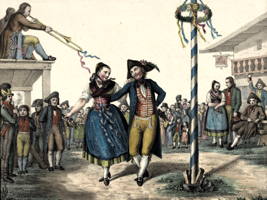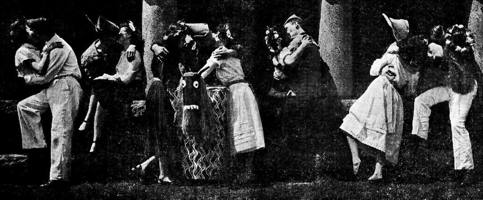
|
The Society of Folk Dance Historians (SFDH)
Magicking in the Spring
[
Home |
About |
Encyclopedia | CLICK AN IMAGE TO ENLARGE |
 |
Of course, you're not superstitious . . . but honestly now, not between you and me, but just between you and yourself, don't you feel a wee tinge of psychic uneasiness on Friday the 13th, or perhaps when a black crosses your path? Silly? Are you sure? . . .
Cautious scientists these days no longer dismiss as "rubbish" all the old beliefs and customs; far to many old-wives tales and witchdoctor remedies have proved to be grounded in fact. Today, in many of our respectable universities, sober investigations are being made of such outré subjects as extra-sensory perception, telekinesis, and clairvoyance. They call it parapsychology today; yesterday it was . . . witchcraft.
 Of all the old festivals, the ceremony of the Renewal of Nature, the return of life in the Spring, was perhaps the one that left the deepest impression in the minds of men and women. The real power of this impression becomes evident when we find that with the advent of Christianity, the old Spring customs were not abolished along with the pagan gods, but were taken into the Church; we find may old church records listing sums "Payed to the Minstrells upon May Day" and "For felling and bringing home the Bough." Even to such a late period as just before the World War II, a whole troop of May Day Hobby Horses attended church once a year at Frejus in Provence; they sat on the Alter steps during Mass. In Portugal, Maypoles are called "St. John's Poles."
Of all the old festivals, the ceremony of the Renewal of Nature, the return of life in the Spring, was perhaps the one that left the deepest impression in the minds of men and women. The real power of this impression becomes evident when we find that with the advent of Christianity, the old Spring customs were not abolished along with the pagan gods, but were taken into the Church; we find may old church records listing sums "Payed to the Minstrells upon May Day" and "For felling and bringing home the Bough." Even to such a late period as just before the World War II, a whole troop of May Day Hobby Horses attended church once a year at Frejus in Provence; they sat on the Alter steps during Mass. In Portugal, Maypoles are called "St. John's Poles."
At any rate, let us concede for the moment that there might be a little something to the whole business and examine the requirements for a "proper" observance of the festival.
In the old days, it was customary for the Mayers to collect flowers and greenery in the woods and fields, starting the day before and making an all-night part of it with the license allowed at the pagan feasts. This comes under head of privilege, however, and not ritual, which, properly, would start with the procuring of the Maypole. After considerable search (embarrassed, not by lack of material, but by the bulk of it) we have condensed the apparently essential rites of the British Isles and various European countries into a homogeneous ceremony the outline of which we here present.
The most pressing necessity would seem to be a proper person to perform the offices; as no mortal is clean in the thaumatological sense, a purification is necessary, and the traditional instrument for this purpose is fire; by preference no common fire, but need-fire or tein-eigen, the sacred fire of the Beltane Festivals, kindled by the prescribed methods. Through this flame the selected man leaps three times, and thus cleansed is ready to cut the Maypole.
First, the tree-spirit must be propitiated; the usual offering is fermented honey or beer, a sip of which is taken by the candidate, the remainder being poured on the ground at the base of the tree, which is then felled, using a bronze or stone axe; iron has been held in disfavor for ceremonial purposes in all parts of the world since before the dawn of history, and the tree-feller can have none on his person nor can those who kindle the need-fire.
Subsidiary ceremonies are now in order; the Old Man of the Woods is burned in effigy, the Beltane cake is eaten, the women wash their faces in May Dew (to ensure rosy cheeks for the entire year), and those with wishes to make throw their bread on the fire.
Characters at Maypole Dances usually include the May Bride (Queen-of-the-May), Jack-in-the-Green, and the Hobby Horse (Hoss); equivalents of these appear in all European countries, whether the festival is celebrated on May Day, St. John's Day, or Midsummer's Eve.
In France, the Hobby-Hoss is sometimes very large with several men underneath; in parts of Spain it appears as a dragon, breathing smoke. The "cutest" one is probably the Greek version, which wears the white Attic "kilts" and sports a lace saddle-cloth.
English Hosses often carried black-lead with which they smeared women who were dragged under the "blanket," sprinkling bystanders with water was also a favorite pastime. An interesting practice was the formal sprinkling of Jack-in-the-Green as drouth insurance measure.
The May-Queen is sometimes a village belle arrayed in finery of flowers and ribbons; sometimes a man disguised in bride's clothing, or again, a little girl bearing the May-standard. These standards vary; the more usual one being a pole surmounted by concentric wreaths within which are displayed either gold and silver spheres representing the Sun and Moon, or an image of the patron saint of the locality.
Continental variants of the English Jack-in-the-Green include Green Georege, Green Wolf, Leaf King, etc.; all follow the same pattern; a man covered with greenery.
The Maypole is an even more popular tradition in France than in England and is still honored today. The favorite musical instrument is the hurdy-gurdy; it is very partial to kissing under the Pole. ☛ Leap Year note: a girl kissed three times under the Maypole is sure to be married within the year.
Many provinces in Spain have masked dancers who cavort around the Pole and recite satirical verses about local dignitaries; Basque provinces hold the festival during the last week of Lent.
The Basques, not the English, were the ones who originally plaited the Pole, this being a modern addition to the British scene. The only dance definitely known to have been danced around the English Maypole is Sellinger's Round: we may, however, safely assume that other dances of this construction (particularly Gathering Peascods) were at one time Maypole dances. In more modern times, we find mention of Green Garters being performed around a Pole.
Before the recent war, May Day had been built up to a national holiday in Germany; elaborate Maypoles were erected, wreaths hung on trees and flagpoles, and many old ceremonies revived.
The marriage of the wood-spirit (Jack-in-the-Green) and the May Queen ensures good crops for the season. The mock marriages often seen at Halloween parties are apparently relics of the Old May-Bride custom; the boy and girl stood under the Maypole while a knot was tied in a cord held between them. They kissed and were then considered man and wife for the evening.
For those who wish to pursue the subject in extenso, we here list a portion of the material available. "Popular Antiquities of Great Britain" by John Brand, "Romane Questions" by Plutarch, "Customs of the World" by Walter Hutchinson, "Myth and Ritual in Dance Game and Rhyme" by Lewis Spence, "Pyrenean Festivals" by Violet Alford, "The Golden Bough" by Sir James George Frazer, "The Hooden Horse" by Percy Maylam, "Das Octoberross" by Wilholm Mannhard, "Nationaler Feiertag des Deutschen Volkes," "Le Folklore de France by Paul Sebillot, "Manual de Folklore Francais Contemporain" by Arnold Van Gennep, Journal of the Royal Institution of Cornwall Vol. 19 Pt. 2p 241-273, and English Folk Dance and Song Society Journal Vol. 3 No. 4.
Society for the Re-Animation of Interesting Superstitions practice their May Day rites
at Lambert Castle, Paterson, New Jersey.
DOCUMENTS
- Rod and Helen La Farge, an article.
- Rosin the Bow, an article.
Printed in Rosin the Bow, 2nd Quarter 1950.
This page © 2018 by Ron Houston.
Please do not copy any part of this page without including this copyright notice.
Please do not copy small portions out of context.
Please do not copy large portions without permission from Ron Houston.
